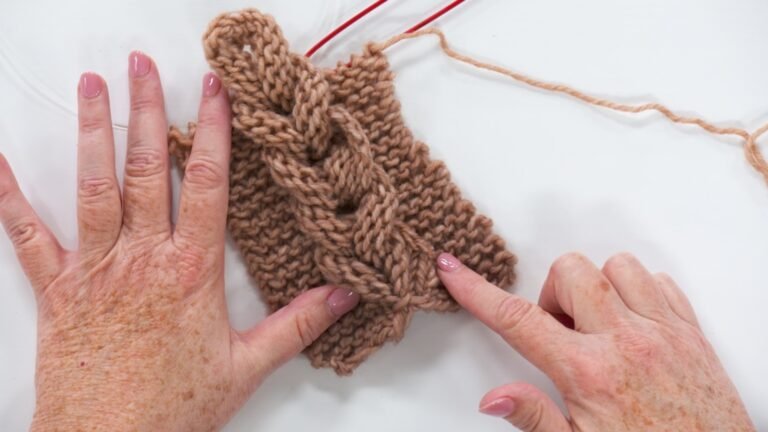The Architectural Intelligence of Advanced Knitting
Beyond the foundational knit and purl, the craft of knitting evolves into a sophisticated system of textile engineering. Advanced techniques such as cables, lace, and circular knitting are not merely decorative; they represent a mastery of structural manipulation, transforming simple yarn into fabrics with complex, three-dimensional properties and engineered fit. These methods, rooted in historical necessity and refined over generations, demonstrate a profound, intuitive understanding of physics, mathematics, and material science, culminating in garments that are both aesthetically compelling and functionally superior.
Cables: Sculpting with Tension and Structure
Cable knitting is the art of creating raised, rope-like patterns through the methodical permutation of stitches. [1] This technique, most famously embodied in the Aran sweaters of Ireland, involves temporarily holding a set of stitches on a separate cable needle and knitting them out of sequence, forcing columns of stitches to cross over one another. [2][3] The result is a fabric with significant textural relief and density. The three-dimensional quality of cables creates air pockets within the fabric, substantially increasing its insulating properties—a feature born from the practical needs of fishermen on the harsh Atlantic coast. [4][5] The visual language of these cables, once thought to be clan identifiers, is more accurately a rich symbolism representing the fishermen’s tools and environment, such as ropes and nets. [2][6] While the myth of identifying drowned sailors by their sweater’s clan-specific pattern has been debunked, the cultural heritage remains potent. [4][7] The structural integrity of a cable is highly dependent on yarn choice. A yarn with a high ply count and tight twist, such as a 3-ply or 4-ply worsted-spun wool, will create sharp, defined cables that stand proud of the background fabric. [8] In contrast, a 2-ply or woolen-spun yarn tends to flatten, softening the cable’s definition but creating a different, gentler texture. [8][9]
Lace: The Mathematics of Negative Space
Lace knitting is a delicate interplay between yarn-over increases and corresponding decreases, which together create a fabric defined by its stable, aesthetically arranged holes. [10] This technique is often considered a pinnacle of the craft, as it requires meticulous attention to stitch counts and pattern repeats. [11] The underlying principle of most lace patterns is the mathematical balance within each pattern row or repeat; for every yarn-over (an increase), there must be a corresponding decrease (like a ‘knit two together’) to maintain a consistent stitch count and prevent the fabric from growing uncontrollably. [12] The visual effect of the lace is a direct result of the physics of blocking. [13] Fresh off the needles, a lace project often appears as a crumpled, indistinct fabric. [14] The process of wet-blocking—saturating the fibers with water, stretching the piece, and pinning it to dry—allows the yarn’s memory to be reset. [13][15] As the fibers relax and then dry under tension, the yarn-overs open up into their characteristic eyelets, and the decreases pull stitches together, revealing the intricate geometric or organic motifs. [14][16] Historic traditions like Shetland lace, famous for “wedding ring shawls” so fine they could be pulled through a ring, relied on exceptionally fine, hand-spun wool and the knitter’s deep experience, as patterns were often not written down. [17][18] The popularity of Shetland lace surged in Victorian England, largely due to Queen Victoria’s patronage. [19][20]
Circular Knitting: Engineering Seamless Forms
Circular knitting represents a paradigm shift from flat-piece construction to the creation of seamless, tubular garments. This method, which utilizes circular or double-pointed needles, has historical roots in functional garments like the fishermen’s Ganseys of the British Isles, which were prized for their durability and comfort without seams. [21] The modern evolution of this technique has led to two primary methodologies for sweater construction: top-down and bottom-up. [22][23] Top-down construction begins at the neckline, with stitches increased at regular intervals to form the yoke, which drapes over the shoulders. [22] Its primary advantage is the ability to try on the garment as it progresses, allowing for real-time adjustments to length and fit. [22][24] However, a potential structural weakness is that the entire weight of the sweater hangs from the cast-on edge at the neckline, which can lead to stretching over time without reinforcement. [25] Conversely, bottom-up construction involves knitting the body and sleeves as separate tubes to the underarm, then joining them to work the yoke with decreases toward the neck. [22][23] This method provides greater structural stability, as the seamed or grafted underarms help support the garment’s weight, but it offers less flexibility for fit adjustments during the knitting process. [22][25] The advent of industrial seamless knitting technology, first introduced in 1995, has revolutionized the apparel industry by eliminating post-production cutting and sewing, drastically reducing fabric waste and allowing for rapid response to fashion trends. [26][27]



